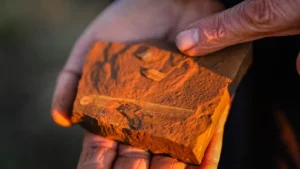16-Million-Year-Old Fossil Reveals Prehistoric Fish’s Last Meal

What if you could peer back in time—millions of years—to see what creatures were eating for lunch? That’s exactly what scientists did when they discovered a stunningly preserved fossil in Australia. This ancient find isn’t just fascinating—it’s also changing the way we understand prehistoric life. Let’s dive in (pun intended!) and explore what this remarkable, 16-million-year-old fossil is teaching us.
Fossil Discovery: A Window Into the Past
Earlier this year, researchers digging near the coastal area of Gulgong in New South Wales, Australia unearthed something truly special: a fossilized fish with another fish in its stomach. Yes, you read that right! This fossil, dating back roughly 16 million years, shows a fish caught in the act of eating its last meal.
Preservation this perfect is incredibly rare. Usually, dead animals decay quickly or are eaten by scavengers. So, stumbling across a fossil where one animal is clearly mid-meal is like winning the paleontology lottery.
Why Is This Fossil So Special?
Sure, fossils are cool—but what makes this one stand out? Well, it not only shows two creatures (a predator and its prey) fossilized together, but both are amazingly intact. Even the bones of the smaller fish—the one inside the stomach—are clearly visible.
That’s just not something you see every day. In fact, scientists say this level of preservation can reveal detailed information about:
- Prehistoric food chains: Who was eating whom back then?
- Ancient ecosystems: What did underwater life look like 16 million years ago?
- Behavior and hunting patterns: Was this fish an aggressive hunter or a more opportunistic feeder?
Think of this fossil like a prehistoric crime scene—only instead of detectives, we have paleontologists trying to piece together what happened millions of years ago.
What Did the Fish Eat?
The larger fossilized fish is called a baharichthys, and inside its stomach sat a much smaller fish, likely a herring or a similar baitfish species. While the smaller one didn’t make it, its appearance gives us rare clues.
In modern times, this kind of predator-prey relationship is common in freshwater ecosystems. The bigger fish eat the smaller ones, keeping the population in balance. So, seeing the same pattern from the Miocene era (that’s the time period 16 million years ago) tells us that some things haven’t changed much—nature’s food chain was already hard at work back then!
How Did It Get Preserved So Well?
This fossil was found in an area that was once a lush rainforest with many lakes and rivers. Researchers believe the fish likely died during a rapid environmental event, such as a sudden drop in oxygen levels or a quick burial by sediment.
Because the fish was quickly covered and not eaten by predators, its body—and its stomach contents—were preserved in stunning detail. It’s a bit like freezing food to keep it fresh, only on a much, much longer timeline.
Similar Fossils Found Nearby
Interestingly, this wasn’t a lone find. Scientists working at the site also discovered fossilized frogs, insects, plants, and other animals. All of these pieces together provide a snapshot of an ancient world teeming with life.
Imagine being able to walk through that rainforest 16 million years ago. You’d see strange, now-extinct animals moving through thick greenery, while birds and bugs filled the air with sound. The lake where this fish lived would have been full of danger—for both predator and prey.
What This Means for Science—and Us
Fossils like this help scientists build a clearer picture of Earth’s history. They allow us to better understand:
- How ecosystems evolve and recover after mass changes
- How climate shifts influence different species (and possibly lead to extinction)
- How present-day species are linked to their ancient relatives
And here’s where it gets really interesting: by studying the climate and environment of the past, we can better predict what might happen in the future. As climate change continues to affect our planet, fossils offer us a natural point of reference.
Why Should You Care?
You might be thinking—cool fossil, but how does this affect my day-to-day life?
Fair question.
Here’s the thing: the more we understand about Earth’s past, the better equipped we are to handle today’s environmental challenges. Knowing what led to ancient extinctions or climate shifts can help us protect modern species—and even ourselves.
Plus, there’s just something awe-inspiring about being able to look at a fossil and think, “This creature lived millions of years ago—and we’re still learning from it today.”
Fun Fact: Prehistoric Fast Food?
Some scientists jokingly referred to this fossil as “prehistoric fast food.” Why? Because it shows a quick, possibly unfortunate meal that the bigger fish never got to digest. It’s like ordering takeout and—oops!—never getting to eat it.
Humor aside, the discovery has sparked excitement among researchers all over the world. It’s a small but powerful piece of the Earth’s puzzle.
Final Thoughts: Nature’s Time Capsules
Fossils are like messages in a bottle, sent from the past straight into our hands. This one in particular—a fossilized record of the last moments between predator and prey—speaks volumes. It tells a story of survival, surprise, and natural instincts that span millennia.
It also reminds us of something very human: the constant curiosity we hold for the world around us. Whether we’re gazing at stars or digging through rocks, we all want to know where we came from—and where we might be headed.
So the next time you’re near a museum, nature preserve, or even just scrolling through science news, remember: the Earth holds countless secrets. We just need to keep digging.
If You Enjoyed This Story, You Might Also Like:
- 10 Incredible Fossils That Changed What We Know About Evolution
- How Dinosaurs Really Lived: What New Finds Are Revealing
- Why Australia Is a Hotspot for Fossil Discoveries
Stay curious, friends. The next big discovery might just be lying under our feet.



